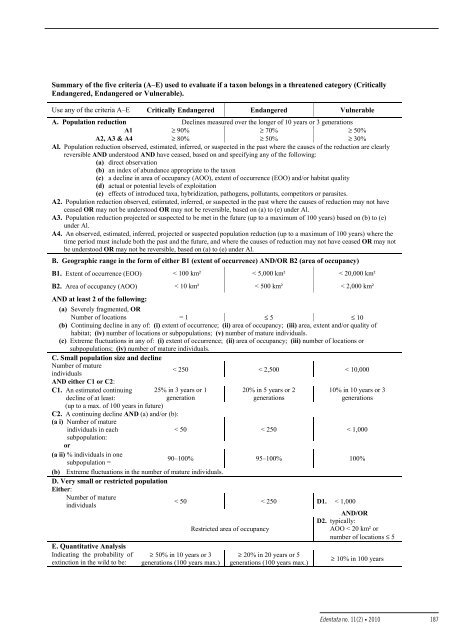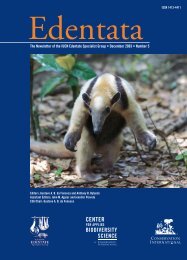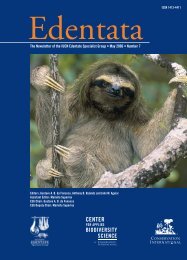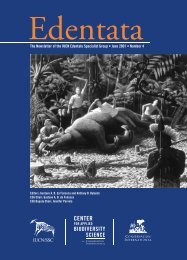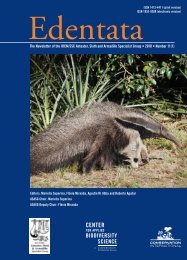Edentata 11(2), 2010 - Anteater, Sloth & Armadillo Specialist Group
Edentata 11(2), 2010 - Anteater, Sloth & Armadillo Specialist Group
Edentata 11(2), 2010 - Anteater, Sloth & Armadillo Specialist Group
- No tags were found...
You also want an ePaper? Increase the reach of your titles
YUMPU automatically turns print PDFs into web optimized ePapers that Google loves.
Summary of the five criteria (A–E) used to evaluate if a taxon belongs in a threatened category (CriticallyEndangered, Endangered or Vulnerable).Use any of the criteria A–E Critically Endangered Endangered VulnerableA. Population reduction Declines measured over the longer of 10 years or 3 generationsA1 ≥ 90% ≥ 70% ≥ 50%A2, A3 & A4 ≥ 80% ≥ 50% ≥ 30%Al. Population reduction observed, estimated, inferred, or suspected in the past where the causes of the reduction are clearlyreversible AND understood AND have ceased, based on and specifying any of the following:(a) direct observation(b) an index of abundance appropriate to the taxon(c) a decline in area of occupancy (AOO), extent of occurrence (EOO) and/or habitat quality(d) actual or potential levels of exploitation(e) effects of introduced taxa, hybridization, pathogens, pollutants, competitors or parasites.A2. Population reduction observed, estimated, inferred, or suspected in the past where the causes of reduction may not haveceased OR may not be understood OR may not be reversible, based on (a) to (e) under Al.A3. Population reduction projected or suspected to be met in the future (up to a maximum of 100 years) based on (b) to (e)under Al.A4. An observed, estimated, inferred, projected or suspected population reduction (up to a maximum of 100 years) where thetime period must include both the past and the future, and where the causes of reduction may not have ceased OR may notbe understood OR may not be reversible, based on (a) to (e) under Al.B. Geographic range in the form of either B1 (extent of occurrence) AND/OR B2 (area of occupancy)B1. Extent of occurrence (EOO) < 100 km² < 5,000 km² < 20,000 km²B2. Area of occupancy (AOO) < 10 km² < 500 km² < 2,000 km²AND at least 2 of the following:(a) Severely fragmented, ORNumber of locations = 1 ≤ 5 ≤ 10(b) Continuing decline in any of: (i) extent of occurrence; (ii) area of occupancy; (iii) area, extent and/or quality ofhabitat; (iv) number of locations or subpopulations; (v) number of mature individuals.(c) Extreme fluctuations in any of: (i) extent of occurrence; (ii) area of occupancy; (iii) number of locations orsubpopulations; (iv) number of mature individuals.C. Small population size and declineNumber of matureindividuals< 250 < 2,500 < 10,000AND either C1 or C2:C1. An estimated continuingdecline of at least:25% in 3 years or 1generation20% in 5 years or 2generations10% in 10 years or 3generations(up to a max. of 100 years in future)C2. A continuing decline AND (a) and/or (b):(a i) Number of matureindividuals in eachsubpopulation:or(a ii) % individuals in onesubpopulation =< 50 < 250 < 1,00090–100% 95–100% 100%(b) Extreme fluctuations in the number of mature individuals.D. Very small or restricted populationEither:Number of matureindividuals< 50 < 250 D1. < 1,000AND/ORD2. typically:Restricted area of occupancyAOO < 20 km² ornumber of locations ≤ 5E. Quantitative AnalysisIndicating the probability ofextinction in the wild to be:≥ 50% in 10 years or 3generations (100 years max.)≥ 20% in 20 years or 5generations (100 years max.)≥ 10% in 100 years<strong>Edentata</strong> no. <strong>11</strong>(2) • <strong>2010</strong> 187


